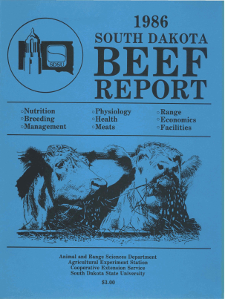
South Dakota Beef Report, 1986
Document Type
Report
Report Number
86-29
Publication Date
1986
Keywords
Range improvement, prescribed burning, forage yields
Summary
Annual yields of western wheatgrass and total vegetation were increased on a clayey range site following mechanical treatment. More important to the range manager, year t o year variability in forage production was reduced, since soil moisture is stabilized. Yields of Japanese brome, an annual grass, increased from the second through the fourth growing seasons after treatment. Three consecutive years of abundant fall precipitation beginning in 1980 probably triggered seed germination of this invader plant. Prescribed burning of the mechanical range treatments drastically reduced production of Japanese brome and increased forage quality. Both quantity and quality of western wheatgrass increased after burning. Prescribed burning did not negatively impact yields of total vegetation. Reducing the yield of an undesirable species such as Japanese brome causes an increase in percentage composition, if not the yield, of desirables such as western wheatgrass. Therefore, range condition percentage and carrying capacity should be higher. Further prescribed burning research in South Dakota would appear to be important since the cost of this practice is relatively low compared with most, if not all, other range improvement practices.
Number of Pages
6
Type
text
Format
application/pdf
Language
en
Publisher
South Dakota State University
Rights
Copyright © 1986 South Dakota State University
Recommended Citation
Gartner, F.R.; White, E.M.; and Butterfield, R.I., "Mechanical Treatment and Burning for High Quality Range Forage" (1986). South Dakota Beef Report, 1986. 30.
https://openprairie.sdstate.edu/sd_beefreport_1986/30

